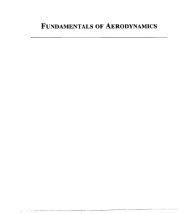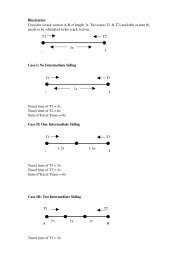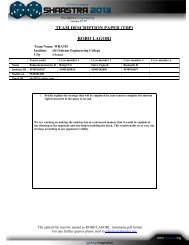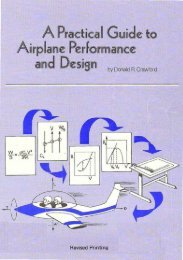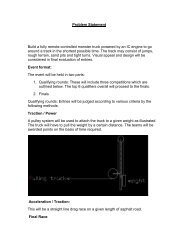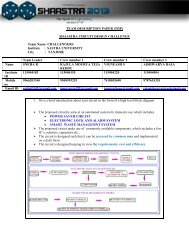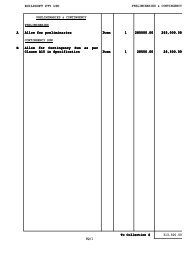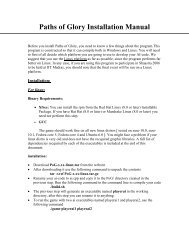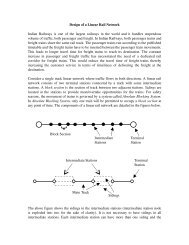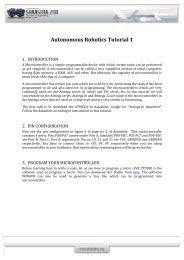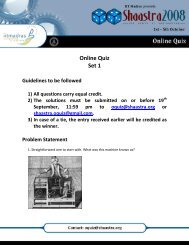IDP_Problem Statement - Shaastra
IDP_Problem Statement - Shaastra
IDP_Problem Statement - Shaastra
You also want an ePaper? Increase the reach of your titles
YUMPU automatically turns print PDFs into web optimized ePapers that Google loves.
BioDocks!, <strong>Shaastra</strong> 2011, IIT Madras<br />
<strong>Problem</strong> statement from VLife Sciences Technologies Pvt Ltd.,Pune, India<br />
Background:<br />
Computer aided drug design approaches in general and target structure based<br />
approaches in particular, play key roles in the entire domain of drug design and<br />
discovery. Among structure based approaches, molecular docking of potential lead<br />
molecules to corresponding protein targets is undeniably one of the most important<br />
methods utilized today world-wide.<br />
In that light and in keeping with the theme of BioDocks!, <strong>Shaastra</strong> 2011, IIT Madras,<br />
we propose the following industrially relevant research problem to all contestants. In<br />
spite of having a rich plethora of docking methods and tools available (both<br />
commercial and public) today, none of them singularly can address pose prediction<br />
closest to the crystal pose of the native ligand generically across diverse targets. The<br />
two key aspects here are the pose generation methods and the corresponding<br />
docking scoring functions.<br />
The problem<br />
In light of that, our present short research project/problem to all contestants is to try<br />
to arrive at a generic methodology to address the broad problem area mentioned<br />
above. The exact steps to be followed are detailed below:<br />
1. We are providing names of a set of 7 co-crystallized protein-native ligand<br />
complexes (cf. Appendix 1) whose structures can be easily downloaded from the pdb<br />
site (http://www.pdb.org) and used for docking. These 7 co-crystallized protein-ligand<br />
complexes are chosen from different protein families corresponding to key<br />
therapeutic areas like diabetes, cancer, inflammation and several others of industrial<br />
and social relevance. We are providing the chain details of the target and the<br />
corresponding co-crystallized ligand names (cf. Appendix 1) as well as the 2D input<br />
sdf files for the co-crystallized ligands to be used for docking.
2. As a broad outline, the contestants are suggested to extract each of the cocrystallized<br />
native ligand out of the corresponding complex and use them as<br />
reference native ligand for alignment with the docked pose later on. It should also be<br />
kept in mind by contestants that appropriate conformers of the co-crystallized ligand<br />
for each target should be used for docking.<br />
3. The conformers are to be docked back to the respective target protein (apo<br />
structure without the ligand) and the best docked pose of the ligand closest to the<br />
original crystal ligand pose has to be found out. This is expected be quantified in<br />
terms of RMSD of alignment of the docked pose with the native crystal pose.<br />
4. The best pose for each such ligand for all the 7 targets are to be recorded by<br />
contestants.<br />
5. The contestants are expected to come up with a methodology/strategy that<br />
generically applies across all 7 targets in terms of best pose (criteria for "best" as<br />
described in point 3 above) capturing. It should be noted that the methodology<br />
should not be biased by any existing binding pose information for finalizing the best<br />
pose. The details of this methodology with its working steps should be reported as<br />
part of the results of the work carried out. This same method has to be applied to a<br />
blind docking test before the judges in the final evaluation phase of the contest.<br />
6. The results of RMSD of alignment of docked pose with native crystal pose for<br />
each ligand across all 7 targets using the same methodology/strategy should be<br />
reported as a Table containing names of each of the ligand, their corresponding<br />
target with the chain used and the RMSD results.<br />
7. The maximum working time allowed for carrying out this work along with the<br />
results report is 15 days.<br />
8. Short-listing of candidates will be done based on their results (as detailed in points<br />
5, 6). The results should contain both the method/strategy developed with any known<br />
docking tool(s) as well as the RMSDs of alignment of docked pose with native crystal<br />
pose for each ligand across all 7 targets.<br />
9. The short-listed candidates are expected to carry out the following at the contest<br />
venue based on which they will be judged for winning positions:
i) Demonstrate the reported RMSD results for any one target (chosen by the judges)<br />
out of the given 7 targets by actually carrying out the docking using their developed<br />
strategy.<br />
ii) Apply their method/strategy to 1-2 protein targets(different from the 7 originally<br />
given) which will be a blind test set provided by VLife Sciences Technologies to all<br />
short-listed contestants on the contest judging day. The results of RMSD of<br />
alignment of docked pose with native crystal pose for each of these 1-2 test set<br />
ligands are to be reported to the judges.<br />
APPENDIX<br />
Serial No. Target PDB ID Co-crystallized<br />
Ligand Name<br />
Chain of Target to<br />
be used<br />
1 1NNY 515 A<br />
2 1O6K ANP A<br />
3 1POE GEL A<br />
4 1Z95 198 A<br />
5 3I6C GIA B<br />
6 3IJJ AVR C<br />
7 3KS9 Z99 A



